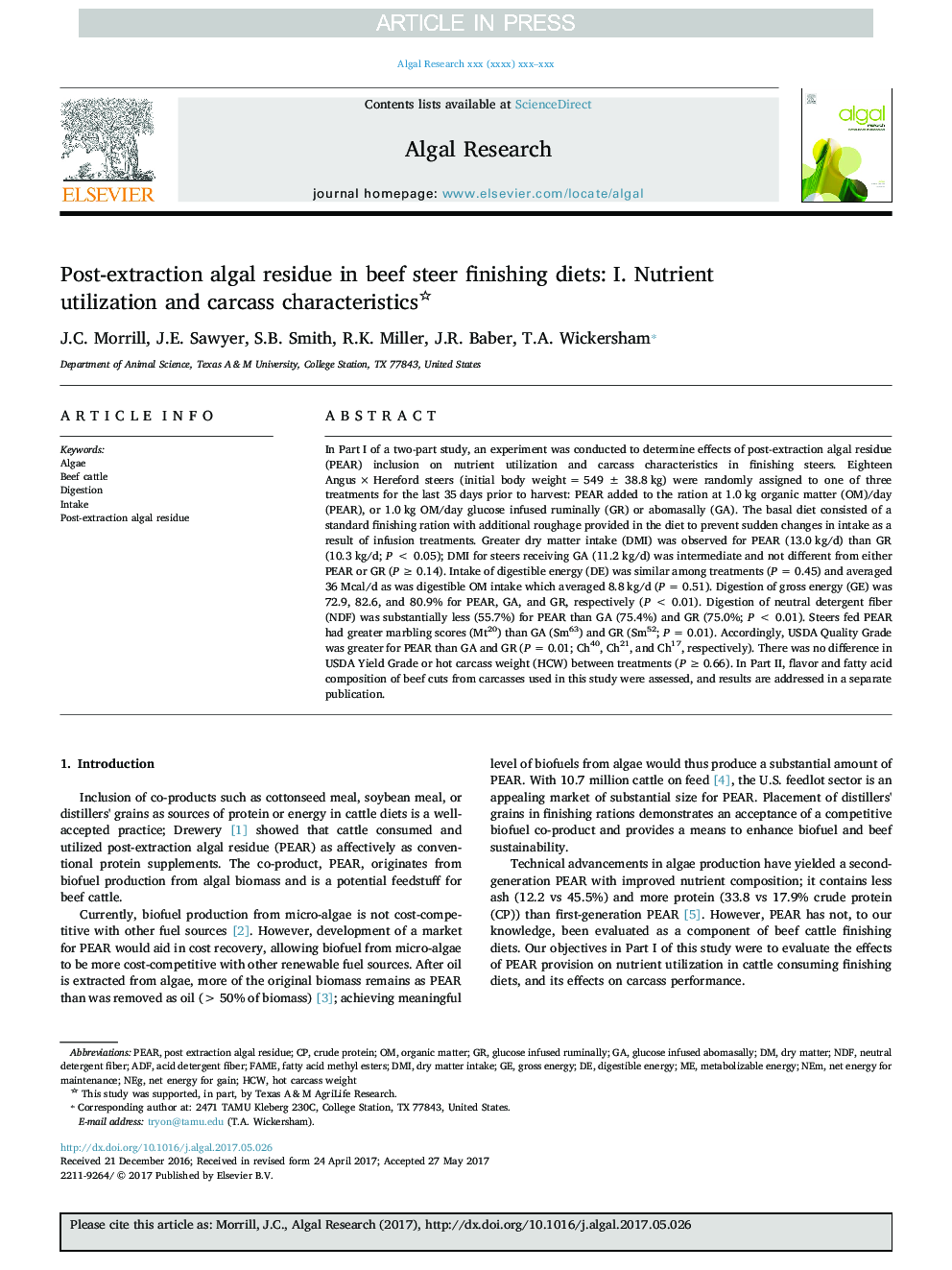| کد مقاله | کد نشریه | سال انتشار | مقاله انگلیسی | نسخه تمام متن |
|---|---|---|---|---|
| 5478412 | 1521808 | 2017 | 5 صفحه PDF | دانلود رایگان |
عنوان انگلیسی مقاله ISI
Post-extraction algal residue in beef steer finishing diets: I. Nutrient utilization and carcass characteristics
دانلود مقاله + سفارش ترجمه
دانلود مقاله ISI انگلیسی
رایگان برای ایرانیان
کلمات کلیدی
ADFHCWNDFDMIacid detergent fiber - الیاف پاک کننده اسیدnet energy for gain - انرژی خالص برای به دست آوردنnet energy for maintenance - انرژی خالص برای نگهداریDigestible energy - انرژی قابل هضمMetabolizable energy - انرژی متابولیزه شدهgross energy - انرژی ناخالصAlgae - جلبک neutral detergent fiber - فیبر مواد شوینده خنثیorganic matter - ماده آلیdry matter - ماده خشکFAME یا fatty acid methyl esters - متیل استرهای اسید چربfatty acid methyl esters - متیل استرهای اسید چربIntake - مصرفdry matter intake - مصرف ماده خشکNEM - نهneg - نگوhot carcass weight - وزن لاشه گرمcrude protein - پروتئین خامBeef cattle - گاو گوشت گاوPear - گلابیDigestion - گوارش یا هضم یا تحلیل
موضوعات مرتبط
مهندسی و علوم پایه
مهندسی انرژی
انرژی های تجدید پذیر، توسعه پایدار و محیط زیست
پیش نمایش صفحه اول مقاله

چکیده انگلیسی
In Part I of a two-part study, an experiment was conducted to determine effects of post-extraction algal residue (PEAR) inclusion on nutrient utilization and carcass characteristics in finishing steers. Eighteen Angus Ã Hereford steers (initial body weight = 549 ± 38.8 kg) were randomly assigned to one of three treatments for the last 35 days prior to harvest: PEAR added to the ration at 1.0 kg organic matter (OM)/day (PEAR), or 1.0 kg OM/day glucose infused ruminally (GR) or abomasally (GA). The basal diet consisted of a standard finishing ration with additional roughage provided in the diet to prevent sudden changes in intake as a result of infusion treatments. Greater dry matter intake (DMI) was observed for PEAR (13.0 kg/d) than GR (10.3 kg/d; P < 0.05); DMI for steers receiving GA (11.2 kg/d) was intermediate and not different from either PEAR or GR (P â¥Â 0.14). Intake of digestible energy (DE) was similar among treatments (P = 0.45) and averaged 36 Mcal/d as was digestible OM intake which averaged 8.8 kg/d (P = 0.51). Digestion of gross energy (GE) was 72.9, 82.6, and 80.9% for PEAR, GA, and GR, respectively (P < 0.01). Digestion of neutral detergent fiber (NDF) was substantially less (55.7%) for PEAR than GA (75.4%) and GR (75.0%; P < 0.01). Steers fed PEAR had greater marbling scores (Mt20) than GA (Sm63) and GR (Sm52; P = 0.01). Accordingly, USDA Quality Grade was greater for PEAR than GA and GR (P = 0.01; Ch40, Ch21, and Ch17, respectively). There was no difference in USDA Yield Grade or hot carcass weight (HCW) between treatments (P â¥Â 0.66). In Part II, flavor and fatty acid composition of beef cuts from carcasses used in this study were assessed, and results are addressed in a separate publication.
ناشر
Database: Elsevier - ScienceDirect (ساینس دایرکت)
Journal: Algal Research - Volume 25, July 2017, Pages 584-588
Journal: Algal Research - Volume 25, July 2017, Pages 584-588
نویسندگان
J.C. Morrill, J.E. Sawyer, S.B. Smith, R.K. Miller, J.R. Baber, T.A. Wickersham,